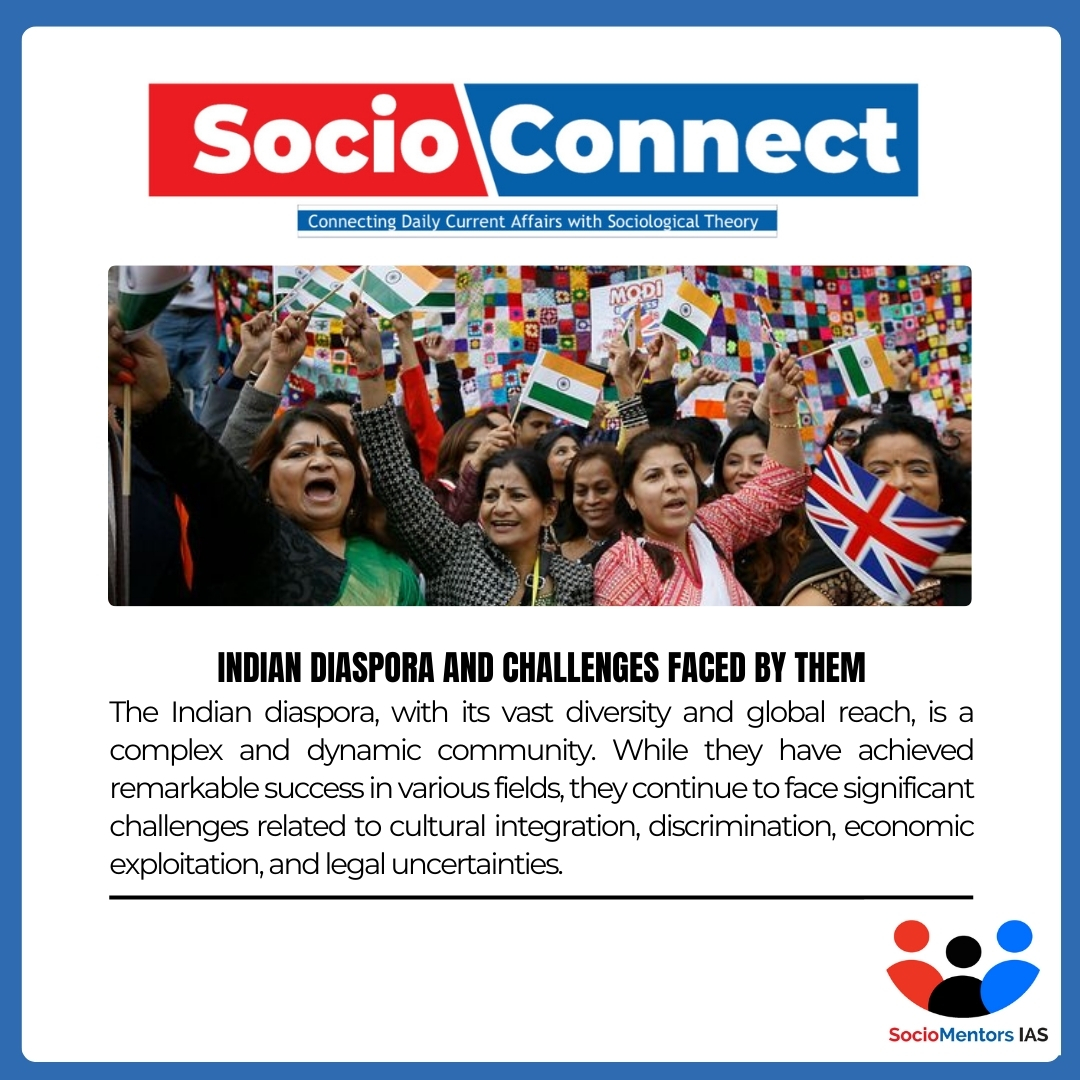Indian Diaspora and Challenges faced by them
September 17, 2024
As of 2015, 15.6 million people born in India were living in other countries. India has been among the world’s top origin countries of migrants since the United Nations started tracking migrant origins in 1990. The number of international Indian migrants has more than doubled over the past 25 years, growing about twice as fast as the world’s total migrant population.
After China, India is the biggest source country for international migrants. International migration from India has been a long-standing phenomenon. As per the Ministry of External Affairs (MEA) data, Indians currently reside in 199 countries (Ministry of External Affairs 2018). The World Bank estimates put India on the top globally in terms of the foreign remittances it receives. In 2018, India received foreign remittances to the tune of $79 billion (World Bank 2019)
Characteristics of Indian Diaspora
- Although migrants take their caste and region and language and other primordial as well as cultural affiliations with them as an inherent part of their being and strive to reproduce them in their new locations, even though perforce they have to make some adaptations. On the other hand, there is a view point (Ganesh 2011) that though these categories do exist in name in the new locations, their structure and meaning may sometimes alter so radically as to be very different from the category in India
- Identity for Indian Diaspora: Arjun Appadurai, in his concept of “global cultural flows” and “ethnoscapes”emphasized that diasporas, is part of a larger, interconnected global system that transcends national borders and through these “ethnoscapes,” members of the diaspora form transnational identities and hybrid cultures. Empirical studies show how at different moments, linguistic, caste or Indian identities come to the fore among diasporic Indians, and which identity is prominent at a given time is situational or a product of deliberate mobilizing.
- for instance, Ganesh (2011: 176-77) points out that in the Gujarati diaspora, caste associations play the role in forging endogamous marital alliances, regional/linguistic based associations and identities regulate much of the day-to-day personal lives and pan-Indian identity comes to the fore when celebrating India’s independence day or Diwali .
- Experience of Women: The experience of women in diaspora has its own specificities in which patriarchal practices of homeland as well as host land combine to create new restraints, pressures and responsibilities for women. Avtar Brah’s concept of “diaspora space” explores how gender intersects with race and class in shaping the diasporic experience. Brah argues that Indian women in the diaspora navigate complex dynamics of gender, where they may face patriarchal control within their own communities as well as discrimination in the wider society.
- Despite the overall hold of patriarchy, under the special circumstances, they had relatively greater mobility and freedom and were able to make personal choices.
- Transnationalism: Schiller, argues that diasporic communities are often linked through transnational social networks that cross national boundaries. These networks connect the diaspora to their homeland economically, politically, and culturally. The Indian diaspora in the Gulf countries, where many low-wage Indian migrant workers maintain strong transnational ties with India. Schiller’s theory helps explain the continuous flow of remittances and the maintenance of social ties through these networks, despite the temporary nature of the workers’ stays.
- Ethnic Enclaves: In many countries, the Indian diaspora forms ethnic enclaves, such as Little India in Singapore, Jackson Heights in New York, and Southall in London. These enclaves serve as hubs for Indian businesses, cultural practices, and social support networks.
- Political Integration: In countries like the U.S., U.K., and Canada, Indian immigrants have integrated into political systems, with several members of the diaspora holding political offices. Kamala Harris, the U.S. Vice President, who has Indian heritage, is an example of the diaspora’s increasing political influence
Issues Faced by Indian Diaspora
- Labour Exploitation: Although there is a promise of better remuneration attached to the large-scale migration of Indian workers to the Gulf, labourers also face considerable exploitation. According to the data tabled by the MEA in Lok Sabha in July 2019, most of the complaints of exploitation recorded by Indians abroad are from Indian embassies located in Saudi Arabia, Qatar, Oman, Kuwait, Bahrain, and the UAE. Increasing number of applications for repatriation from Indians in the Gulf over the years also shows the plight of distressed migrant workers.
- Identity Crisis: Stuart Hall Hall argues that identity in the diaspora is not fixed but fluid, shaped by historical and cultural experiences. He highlights the tension between “roots” (heritage) and “routes” (migration experiences), where migrants must navigate multiple cultural references. Migrants often grapple with maintaining their cultural identity while integrating into the host society. This can lead to tensions between preserving traditional values and adopting new ones, particularly for second and third-generation diaspora members.
- For example, younger members of the diaspora may struggle with familial pressure to follow arranged marriages while they themselves prefer to marry for love or live in a more Western ideal.
- Racism and Xenophobia: Diaspora communities often face racism and xenophobia, especially in countries with a long history of immigration tensions, such as the U.S., U.K., and parts of Europe. Discrimination can limit social mobility and hinder integration into mainstream society.
- Gendered Experiences: Women within the Indian diaspora experience migration differently, often facing double discrimination—both as immigrants and as women. They are more vulnerable to exploitation in the workforce and domestic settings.
- Caste Experiences: Caste also persists within the Indian diaspora, affecting social relations, marriage patterns, and community organization abroad. Caste discrimination has emerged as a challenge even in multicultural societies where caste is not legally recognized.
Real-world case studies from different regions—ranging from labour conditions in the Gulf to racial tensions in the U.K.—illustrate the diversity of challenges faced by Indian migrants across the globe. Gap in migration data and diaspora also make it hard to device policies for the benefit of Indian migrants abroad. Pravasiya Bhartiya Divas, OCI Scheme, Know India Programme etc has been devised by the government to connect migrants to their roots.



